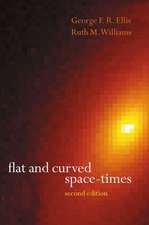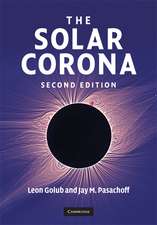Light Curve Modeling of Eclipsing Binary Stars
Editat de E.F. Miloneen Limba Engleză Paperback – 18 sep 2011
Preț: 636.30 lei
Preț vechi: 748.59 lei
-15% Nou
Puncte Express: 954
Preț estimativ în valută:
121.79€ • 132.34$ • 102.37£
121.79€ • 132.34$ • 102.37£
Carte tipărită la comandă
Livrare economică 21 aprilie-05 mai
Preluare comenzi: 021 569.72.76
Specificații
ISBN-13: 9781461276494
ISBN-10: 1461276497
Pagini: 212
Ilustrații: VI, 202 p.
Dimensiuni: 155 x 235 x 11 mm
Greutate: 0.3 kg
Ediția:Softcover reprint of the original 1st ed. 1993
Editura: Springer
Colecția Springer
Locul publicării:New York, NY, United States
ISBN-10: 1461276497
Pagini: 212
Ilustrații: VI, 202 p.
Dimensiuni: 155 x 235 x 11 mm
Greutate: 0.3 kg
Ediția:Softcover reprint of the original 1st ed. 1993
Editura: Springer
Colecția Springer
Locul publicării:New York, NY, United States
Public țintă
ResearchDescriere
In the two decades since the development of the first eclipsing-binary modeling code, new analytic techniques and the availability of powerful, sometimes dedicated computing facilities have made possible vastly improved determinations of fundamental and even transient stellar parameters. The scale of these developments, of course, raises questions about modeling tools, techniques, and philosophies, such as: Who will maintain and upgrade the codes? Will the codes be open to improvement by outsiders, and if so, how? And, indeed, what should be the goals of a modeling program? Such questions had not been aired for a long time and, for this reason alone, deserved to be discussed in as general a forum as the community provides. This volume contains material presented by Commission 42 (Close Binary Stars) during the International Astronomical Union's XXI General Assembly in Argentina, July 1991, and during IAU Colloquium 151, Cordoba, Argentina, August 1991. The techniques discussed include simulations of stellar bright and dark spots, streams, partial and complete stellar disks, prominences, and other features characterizing active stars; modeling of polarization parameters; models that use radial velocities as well as line profile simulations to model velocity field variation across stellar disks; the weighted effects of brightness asymmetries; and models for translucent eclipsing agents such as stellar winds.
Cuprins
Improvements in the Modeling of Eclipsing Binary Light Curves — An Introduction.- From Here to Observables: Beyond Light and Velocity Curves.- Spectral Energy Distributions of Circumstellar Gas in Algols.- Gradient Free Determination of Eclipsing Binary Light Curve Parameters — Derivation of Spot Parameters Using the Simplex Algorithm.- The New Wilson Reflection Treatment and the Nature of BF Aurigae.- Binary Star Rotation from Line Profiles.- Improvements to the Wilson-Devinney Code on Computer Platforms at the University of Calgary.- New Atmospheres for Modelling Binaries and Disks.- Light Synthesis Modeling of Close Binary Stars.- Current Status of the EBOP Code.- Improving the Light Curve Synthesis Program EBOP: Variable Position of the Periastron and Second Order Limb Darkening.- Linear and Non-Linear Limb Darkening Coefficients for Synthetic Light Curve Modeling of Binary Stars.- Light2: A Light-Curve Modeling Program.- Binary Maker 2.0 — An Interactive Graphical Tool for Preliminary Light Curve Analysis.- Problems Arising in the Modeling of the W Ser-Type Binary RX Cas.- Spot Solutions for Two RS CVn Systems: ER Vul and V711 Tau.- The Information Limit Optimisation Technique.- Comments on Light Curve Modelling Techniques and a Review of a Poster Paper.- Some Comments on Light Curve Solutions of Eclipsing Binary Systems.- Discussion.- Concluding Remarks.












